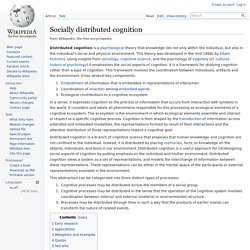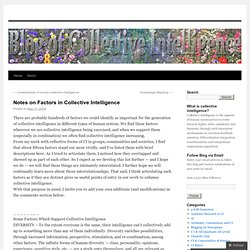

1-explorations. Personnal Data. Stigmergy. Custom & Co Search. Browser Automation. Serendipity-Sérendipité. Distributed Computing. 2-Social Networks. C.F.O.I.R. Evidence for a Collective Intelligence Factor in the Performance of Human Groups. Critical mass (sociodynamics) In social dynamics, critical mass is a sufficient number of adopters of an innovation in a social system so that the rate of adoption becomes self-sustaining and creates further growth.

It is an aspect of the theory of diffusion of innovations, written extensively on by Everett Rogers in his book Diffusion of Innovations.[1] Social factors influencing critical mass may involve the size, interrelatedness and level of communication in a society or one of its subcultures. Another is social stigma, or the possibility of public advocacy due to such a factor. Critical mass may be closer to majority consensus in political circles, where the most effective position is more often that held by the majority of people in society. In this sense, small changes in public consensus can bring about swift changes in political consensus, due to the majority-dependent effectiveness of certain ideas as tools of political debate. The concept of critical mass had existed before it entered a sociology context.
Network effect. Diagram showing the network effect in a few simple phone networks.

The lines represent potential calls between phones. The classic example is the telephone. The more people who own telephones, the more valuable the telephone is to each owner. This creates a positive externality because a user may purchase a telephone without intending to create value for other users, but does so in any case. Online social networks work in the same way, with sites like Twitter, Facebook, and Google+ becoming more useful as more users join. The expression "network effect" is applied most commonly to positive network externalities as in the case of the telephone. Over time, positive network effects can create a bandwagon effect as the network becomes more valuable and more people join, in a positive feedback loop. Origins[edit] Network effects were a central theme in the arguments of Theodore Vail, the first post patent president of Bell Telephone, in gaining a monopoly on US telephone services. Crowdsourcing. 3-Visualizations & mapping.
Visual Understanding Environment. 4-Veille. Real time. Systems Thinking. 5-curation. Human-based computation. Human-based computation (HBC) is a computer science technique in which a machine performs its function by outsourcing certain steps to humans. This approach uses differences in abilities and alternative costs between humans and computer agents to achieve symbiotic human-computer interaction. In traditional computation, a human employs a computer[1] to solve a problem; a human provides a formalized problem description and an algorithm to a computer, and receives a solution to interpret. Human-based computation frequently reverses the roles; the computer asks a person or a large group of people to solve a problem, then collects, interprets, and integrates their solutions. Early work[edit] Human-based computation (apart from the historical meaning of "computer") research has its origins in the early work on interactive evolutionary computation.
Cognitive side... Intelligence Forms. Socially distributed cognition. Distributed cognition is a psychological theory that knowledge lies not only within the individual, but also in the individual's social and physical environment.

This theory was developed in the mid-1980s by Edwin Hutchins. Using insights from sociology, cognitive science, and the psychology of Vygotsky (cf. cultural-historical psychology) it emphasizes the social aspects of cognition. It is a framework for studying cognition rather than a type of cognition. This framework involves the coordination between individuals, artifacts and the environment. It has several key components: Game Mechanics & Design. Metamotivation. Basic Income. Notes on Factors in Collective Intelligence.
There are probably hundreds of factors we could identify as important for the generation of collective intelligence in different types of human system.

We find these factors wherever we see collective intelligence being exercised, and when we support them (especially in combination) we often find collective intelligence increasing. From my work with reflective forms of CI in groups, communities and societies, I find that about fifteen factors stand out most vividly, and I’ve listed them with brief descriptions here. As I tried to articulate them, I noticed how they overlapped and showed up as part of each other. So I expect as we develop this list further — and I hope we do — we will find these things are intimately interrelated. I further hope we will continually learn more about those interrelationships. Like this: Like Loading... Comment créer un contexte social favorable à l'intelligence collect...
CognitiveInformaticsCognitiveSynergyPaper_v1 - CognitiveSynergy.pdf.